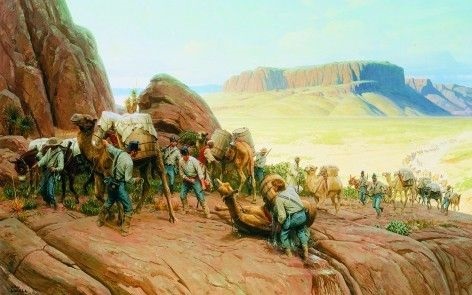Amy M. O'Quinn's Blog
September 26, 2019
Who Was Johnny Appleseed? A Round-Up
 SourceJohn Chapman, better known as Johnny Appleseed, was born on September 26, 1774 in Massachusetts. This pioneering nurseryman traveled around planting apple trees in many of the northeastern American states.Johnny Appleseed became an American legend, and we all picture him walking barefoot, whistling and singing “The Lord is good to me, and so I thank the Lord—for giving me the things I need, the sun, and the rain, and the apple seed…” We imagine him carrying a sack of apple seeds and a B...
SourceJohn Chapman, better known as Johnny Appleseed, was born on September 26, 1774 in Massachusetts. This pioneering nurseryman traveled around planting apple trees in many of the northeastern American states.Johnny Appleseed became an American legend, and we all picture him walking barefoot, whistling and singing “The Lord is good to me, and so I thank the Lord—for giving me the things I need, the sun, and the rain, and the apple seed…” We imagine him carrying a sack of apple seeds and a B...
Published on September 26, 2019 07:42
July 9, 2019
Launch Day Giveaway--and Happy Birthday, Nikola!
 Today is the official release day for my book, Nikola Tesla for Kids: His Life, Ideas, and Inventions, with 21 Activities. Woohoo! And it's almost Nikola Tesla's birthday. He was born on the stroke of midnight between July 9 and 10, 1856, although he normally celebrated his birthday on the 10th. Let's see...that would make him 163 years old tonight! Wow! I think even Mr. Tesla would be amazed at all the technological advances we enjoy in this modern age. It's quite mind-boggling when you stop...
Today is the official release day for my book, Nikola Tesla for Kids: His Life, Ideas, and Inventions, with 21 Activities. Woohoo! And it's almost Nikola Tesla's birthday. He was born on the stroke of midnight between July 9 and 10, 1856, although he normally celebrated his birthday on the 10th. Let's see...that would make him 163 years old tonight! Wow! I think even Mr. Tesla would be amazed at all the technological advances we enjoy in this modern age. It's quite mind-boggling when you stop...
Published on July 09, 2019 11:08
April 10, 2018
It's Time to Fish or Cut Bait!
How to Step Outside Your Comfort Zone and Start Submitting Your Writing
 I’m from the South, and we Southerners love colloquial expressions. They’re fun, and they often put important life-changing maxims into humorous (and memorable) bite-sized statements. And one of my favorites is: It’s time to fish or cut bait!To be honest, this expression has been my mantra more than once in my writing career. It simply means to stop hesitating and move forward instead of giving up and settling for the status quo.Make a DecisionWho wants to cut the bait instead of being the fi...
I’m from the South, and we Southerners love colloquial expressions. They’re fun, and they often put important life-changing maxims into humorous (and memorable) bite-sized statements. And one of my favorites is: It’s time to fish or cut bait!To be honest, this expression has been my mantra more than once in my writing career. It simply means to stop hesitating and move forward instead of giving up and settling for the status quo.Make a DecisionWho wants to cut the bait instead of being the fi...
Published on April 10, 2018 07:20
April 1, 2018
Finding Story Ideas: Is Your 'What Iffer' In Good Working Order?
 Some people are just born with a finely-tuned ‘what-iffer’—and this valuable faculty can churn out some wonderful story generators and ideas for writers. So, is your ‘what-iffer’ in good working order? When you hear of or read about a current news story, do you automatically wonder what would happen if. . .? When you inadvertently overhear an interesting tidbit of conversation as you are out and about, do you find yourself thinking it would make a great line in a book, especially if. . .? Whe...
Some people are just born with a finely-tuned ‘what-iffer’—and this valuable faculty can churn out some wonderful story generators and ideas for writers. So, is your ‘what-iffer’ in good working order? When you hear of or read about a current news story, do you automatically wonder what would happen if. . .? When you inadvertently overhear an interesting tidbit of conversation as you are out and about, do you find yourself thinking it would make a great line in a book, especially if. . .? Whe...
Published on April 01, 2018 18:23
October 17, 2016
The USS Nautilus: Nuclear Science Week
 Nuclear Science Week(NSW) is a national and international, broadly observed week-long celebration to focus local, regional, national and international interest on all aspects of nuclear science. NSW takes place each year on the third week of October, and each day of NSW provides for learning about the contributions, innovations and opportunities that can be found by exploring nuclear science.During the week, educators, students, employers and the community participate in a national recognitio...
Nuclear Science Week(NSW) is a national and international, broadly observed week-long celebration to focus local, regional, national and international interest on all aspects of nuclear science. NSW takes place each year on the third week of October, and each day of NSW provides for learning about the contributions, innovations and opportunities that can be found by exploring nuclear science.During the week, educators, students, employers and the community participate in a national recognitio...
Published on October 17, 2016 20:12
October 13, 2016
Nature at Night: Learning After Dark
 (Source)Do you like the unusual?Why not do a little bit ofscience exploration after dark and shake up the HOW and WHERE for learning? Check out the following books for a start and read some of the descriptions and/orfun facts and ideas I've included below each.*This post contains affiliate links.Discover Nature at Sundownby Elizabeth P. LawlorThere are all kinds of enjoyable learning opportunities just waiting in the shadows, and everyone will have fun—all while experiencing the nocturnal sid...
(Source)Do you like the unusual?Why not do a little bit ofscience exploration after dark and shake up the HOW and WHERE for learning? Check out the following books for a start and read some of the descriptions and/orfun facts and ideas I've included below each.*This post contains affiliate links.Discover Nature at Sundownby Elizabeth P. LawlorThere are all kinds of enjoyable learning opportunities just waiting in the shadows, and everyone will have fun—all while experiencing the nocturnal sid...
Published on October 13, 2016 08:11
September 21, 2016
Glow-Worms: Nature’s Lanterns in World War I Trenches
 (Source)One of my favorite childhood memories is chasing lightning bugs (or fireflies) through the dusky evening woods as the bioluminescent greenish lights from their tiny abdomens flashed on and off. It was magical! In fact, catching the little critters and cupping them in my hands, or temporarily placing a few in a jar for observation, was as much a rite of summer as eating popsicles or building sandcastles!But who knew that this species from theLampyridaefamily also aided soldiers in the...
(Source)One of my favorite childhood memories is chasing lightning bugs (or fireflies) through the dusky evening woods as the bioluminescent greenish lights from their tiny abdomens flashed on and off. It was magical! In fact, catching the little critters and cupping them in my hands, or temporarily placing a few in a jar for observation, was as much a rite of summer as eating popsicles or building sandcastles!But who knew that this species from theLampyridaefamily also aided soldiers in the...
Published on September 21, 2016 18:23
September 20, 2016
Candy Bomber: The Story of the Berlin Airlift's "Chocolate Pilot"-- Book Review
This post contains an affiliate link. Candy Bomber: The Story of the Berlin Airlift's"Chocolate Pilot"Written by: Michael O. TunnellPublished by: Charlesbridge (2010)Grades: 4-7Ages: 9-12The dramatic conclusion to World War II in the European theater is well-documented, and most people know how the Allies stopped Hitler and the Nazi party and defeated Germany. But lesser known are the facts about what happened to that nation and its people in the years immediately following the war’s end.In a...
Candy Bomber: The Story of the Berlin Airlift's"Chocolate Pilot"Written by: Michael O. TunnellPublished by: Charlesbridge (2010)Grades: 4-7Ages: 9-12The dramatic conclusion to World War II in the European theater is well-documented, and most people know how the Allies stopped Hitler and the Nazi party and defeated Germany. But lesser known are the facts about what happened to that nation and its people in the years immediately following the war’s end.In a...
 Candy Bomber: The Story of the Berlin Airlift's"Chocolate Pilot"Written by: Michael O. TunnellPublished by: Charlesbridge (2010)Grades: 4-7Ages: 9-12The dramatic conclusion to World War II in the European theater is well-documented, and most people know how the Allies stopped Hitler and the Nazi party and defeated Germany. But lesser known are the facts about what happened to that nation and its people in the years immediately following the war’s end.In a...
Candy Bomber: The Story of the Berlin Airlift's"Chocolate Pilot"Written by: Michael O. TunnellPublished by: Charlesbridge (2010)Grades: 4-7Ages: 9-12The dramatic conclusion to World War II in the European theater is well-documented, and most people know how the Allies stopped Hitler and the Nazi party and defeated Germany. But lesser known are the facts about what happened to that nation and its people in the years immediately following the war’s end.In a...
Published on September 20, 2016 12:56
April 15, 2016
Science Snippets: Spring Peepers and Pinkletinks
Listen! Do you hear the frog chorus?The Spring Peepers continue to herald the arrival of spring. Their lively trill is always music to my ears after the colder winter months, and it's something I look forward to every year.Spring Peepers (Pseudacris crucifer) are small, nocturnal 'chorus' frogs that live in the eastern United States and Canada. Obviously, they are called Spring Peepers because they begin peeping, singing, and chirping when the weather becomes warmer. In fact, they are usually...
Published on April 15, 2016 09:17
April 8, 2016
History Pops: U. S. Army's Camel Corps Experiment
 Did you know that the U.S. Army once had an experimental 'Camel Corps' right here in America? And one of the key players in pushing the idea forward to reality was none other than the future Confederate president, Jefferson Davis.At the time of the implementation of the Camel Corps experiment (1855) however, Davis held the office of U.S. Secretary of War, under President Franklin Pierce. Davis worked tirelessly to convince both the president and Senate to agree to the project and purchase cam...
Did you know that the U.S. Army once had an experimental 'Camel Corps' right here in America? And one of the key players in pushing the idea forward to reality was none other than the future Confederate president, Jefferson Davis.At the time of the implementation of the Camel Corps experiment (1855) however, Davis held the office of U.S. Secretary of War, under President Franklin Pierce. Davis worked tirelessly to convince both the president and Senate to agree to the project and purchase cam...
Published on April 08, 2016 06:41



